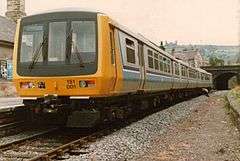British Rail Class 151
The British Rail Class 151 was a prototype class of Diesel multiple unit built by Metro Cammell. Only two 3-car units were built, entering service in 1985.[6][7] They were withdrawn in 1989.[8]
| British Rail Class 151 Sprinter | |
|---|---|
 151001 at Matlock in the summer of 1985 | |
| In service | 1985–1989 |
| Manufacturer | Metro Cammell |
| Order no. |
|
| Family name | Sprinter |
| Replaced | First generation DMUs |
| Constructed | 1985[1] |
| Entered service | 1985[2] |
| Scrapped | 2004[2] |
| Number built | 2 |
| Number scrapped | Both |
| Formation |
|
| Diagram |
|
| Fleet numbers | |
| Capacity |
|
| Operator(s) | Regional Railways |
| Depot(s) | Derby Etches Park[1] |
| Specifications | |
| Car body construction | Aluminium[3] |
| Car length |
|
| Width | 2.81 m (9 ft 2 5⁄8 in)[3] |
| Height | 3.89 m (12 ft 9 1⁄8 in)[3] |
| Floor height | 1.156 m (3 ft 9 1⁄2 in)[4] |
| Doors | Double leaf sliding[3] |
| Articulated sections | 3 |
| Wheelbase | 14.040 m (46 ft 3⁄4 in) (bogie centres)[4] |
| Maximum speed | 75 mph (121 km/h)[3] |
| Weight |
|
| Prime mover(s) | 1 × Cummins NT855R5 (per car)[1] |
| Engine type | Diesel engine |
| Power output | 285 hp (213 kW)[3] |
| Transmission | Hydraulic T211r[1] |
| Bogies | Metro-Cammell[3] |
| Braking system(s) | Air/EP[3] |
| Coupling system | BSI[1][5] |
| Multiple working | Classes 14x, 15x[3] |
| Track gauge | 1,435 mm (4 ft 8 1⁄2 in) standard gauge |
Specification
The vehicles were aluminum bodied and each one was equipped with Cummins NT855 285 hp (213 kW) diesel engines with hot-shift Twin Disc transmissions and Gmeinder final drives. Their maximum speed was 75 mph (120 km/h) and their light weight meant good acceleration.[2]
Problems
The gearboxes would prove to be troublesome, giving jerky shifts and sending violent shocks throughout the train. Problems were never fully rectified until a modified version of the transmission appeared some years later on the Class 154; however interest in the Class 151 or hot-shift gearbox had disappeared by then.[2]
Features
The units had one or two other unusual features including hydraulically driven alternators and cooling fans. The main cooler group and radiators were fitted in a pod on the roof of each vehicle. The bogies were non-standard and this combined with several other unique features led ultimately to their withdrawal in 1989. There were proposals to fit standard Class 150 bogies; however this proved to be impractical.
Withdrawal
The production contract was awarded to the British Rail Engineering Limited built Class 150. After withdrawal the units were stored at Llandudno Junction carriage sheds until they were purchased by Railtest (later Serco Railtest) who had planned to convert them into test units. However, for the same reasons which saw their withdrawal from service, Railtest did not go ahead with any conversions and the units were again stored out in the open in the sidings of the Railway Technical Centre, Derby.
In March 2000, they were bought by a company called Endeavour Rail who planned to refurbish both for spot hire to train operating companies. They were transferred to LNWR at Crewe, but again the proposed refurbishment did not happen and the units remained in the open next to the West Coast Main Line where they would remain until scrapped on site in 2004, their condition having rapidly degenerated in part due to vandalism.[9][10][11]
Formation
| Unit Number | DMSL (68S seats) | MS (84S seats) | DMS (80S seats) |
|---|---|---|---|
| 151001 (151003) | 55202 | 55402 | 55302 |
| 151002 (151004) | 55203 | 55403 | 55303 |
References
- Fox 1987, p. 44
- "The Class 151 Metro-Cammell DMU's". traintesting.com. Archived from the original on 3 March 2016. Retrieved 18 February 2016.
- "Class 151". The Railway Centre. Archived from the original on 8 November 2005. Retrieved 1 February 2016.
- "Diagram". traintesting.com. Archived from the original on 18 March 2016. Retrieved 18 February 2016.
- "System Data for Mechanical and Electrical Coupling of Rail Vehicles". Archived from the original on 5 July 2008. Retrieved 5 January 2009.
- "Class 151 is Met-Cam's bid in DMU replacement battle" Railway Gazette International May 1984 page 364
- "Market" Railway Gazette International April 1985 page 237
- "Metro-Cammell Class 151 Sprinters withdrawn" Rail Magazine 6 April 1989 page 9
- "Class 151 - More Main Line Endeavours Ahead Today's Railways UK issue 53 May 2000 page 43
- "Endeavour discusses 151 lease with TOC" Rail Magazine issue 438 36 June 2002 page 57
- "151s scrapped at Crewe" Rail Magazine issue 484 31 March 2004 page 63
Sources
- Fox, Peter (1987). Multiple Unit Pocket Book. British Railways Pocket Book No.2 (Summer/Autumn 1987 ed.). Platform 5 Publishing. ISBN 0906579740. OCLC 613347580.CS1 maint: ref=harv (link)
External links
![]()